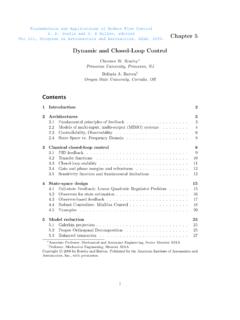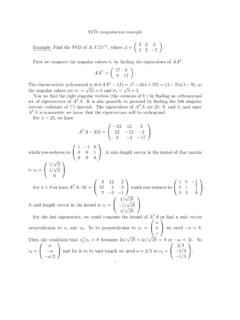Transcription of ON DYNAMIC MODE DECOMPOSITION: THEORY AND …
1 Manuscript submitted to the Journal of Computational DynamicsON DYNAMIC MODE DECOMPOSITION: THEORY AND APPLICATIONSJ onathan H. Tu, Clarence W. Rowley, Dirk M. Luchtenburg,Dept. of Mechanical and Aerospace EngineeringPrinceton UniversityPrinceton, NJ 08544, USAS teven L. Brunton, and J. Nathan KutzDept. of Applied MathematicsUniversity of WashingtonSeattle, WA 98195, introduced in the fluid mechanics community, dynamicmode decomposition (DMD) has emerged as a powerful tool for analyzing thedynamics of nonlinear systems. However, existing DMD THEORY deals primarilywith sequential time series for which the measurement dimension is much largerthan the number of measurements taken. We present a theoretical frameworkin which we define DMD as the eigendecomposition of an approximating lin-ear operator. This generalizes DMD to a larger class of datasets, includingnonsequential time series. We demonstrate the utility of this approach by pre-senting novel sampling strategies that increase computational efficiency andmitigate the effects of noise, respectively.
2 We also introduce the concept oflinear consistency, which helps explain the potential pitfalls of applying DMDto rank-deficient datasets, illustrating with examples. Such computations arenot considered in the existing literature, but can be understood using ourmore general framework. In addition, we show that our THEORY strengthens theconnections between DMD and Koopman operator THEORY . It also establishesconnections between DMD and other techniques, including the eigensystem re-alization algorithm (ERA), a system identification method, and linear inversemodeling (LIM), a method from climate science. We show that under certainconditions, DMD is equivalent to flows often exhibit low-dimensional behavior, despite thefact that they are governed by infinite-dimensional partial differential equations (theNavier Stokes equations). For instance, the main features of the laminar flow past atwo-dimensional cylinder can be described using as few as three ordinary differentialequations [1].
3 To identify these low-order dynamics , such flows are often analyzedusingmodal decompositiontechniques, including proper orthogonal decomposition (POD), balanced proper orthogonal decomposition (BPOD), and DYNAMIC modedecomposition (DMD). Such methods describe the fluid state (typically the veloc-ity or vorticity field) as a superposition of empirically computed basis vectors, or modes. In practice, the number of modes necessary to capture the gross behavior2000 Mathematics Subject : 37M10, 65P99; Secondary: words and mode decomposition , Koopman operator, spectral analysis,time series analysis, reduced-order H. TU ET a flow is often many orders of magnitude smaller than the state dimension of thesystem ( ,O(10) compared toO(106)).Since it was first introduced in [2], DMD has quickly gained popularity in the flu-ids community, primarily because it provides information about thedynamicsof aflow, and is applicable even when those dynamics arenonlinear[3].
4 A typical appli-cation involves collecting a time series of experimental or simulated velocity fields,and from them computing DMD modes and eigenvalues. The modes are spatialfields that often identify coherent structures in the flow. The corresponding eigen-values define growth/decay rates and oscillation frequencies for each mode. Takentogether, the DMD modes and eigenvalues describe the dynamics observed in thetime series in terms of oscillatory components. In contrast, POD modes optimallyreconstruct a dataset, with the modes ranked in terms of energy content [4]. BPOD modes identify spatial structures that are important for capturing linear input-output dynamics [5], and can also be interpreted as an optimal decomposition oftwo (dual) datasets [6].At first glance, it may seem dubious that a nonlinear system could be described bysuperposition of modes whose dynamics are governed by eigenvalues. After all, oneneeds alinearoperator in order to talk about eigenvalues.
5 However, it was shownin [3] that DMD is closely related to a spectral analysis of the Koopman Koopman operator is a linear but infinite-dimensional operator whose modesand eigenvalues capture the evolution of observables describing any (even nonlinear)dynamical system. The use of its spectral decomposition for data-based modaldecomposition and model reduction was first proposed in [7]. DMD analysis canbe considered to be a numerical approximation to Koopman spectral analysis, andit is in this sense that DMD is applicable to nonlinear systems. In fact, the terms DMD mode and Koopman mode are often used interchangably in the of the recent work involving DMD has focused on its application to differentflow configurations. For instance, DMD has been applied in the study of the wakebehind a flexible membrane [8], the flow around high-speed trains [9], instabilitiesin annular liquid sheets [10], shockwave-turbulent boundary layer interactions [11],detonation waves [12], cavity flows [8, 13], and various jets [3, 8, 14, 15, 16, 17].
6 Therehave also been a number of efforts regarding the numerics of the DMD algorithm,including the development of memory-efficient algorithms [18, 19], an error analysisof DMD growth rates [20], and a method for selecting a sparse basis of DMDmodes [21]. Variants of the DMD algorithm have also been proposed, includingoptimized DMD [22] and optimal mode decomposition [23, 24]. Theoretical work onDMD has centered mainly on exploring connections with other methods, such asKoopman spectral analysis [3, 25, 26], POD [8], and Fourier analysis [22]. Theoremsregarding the existence and uniqueness of DMD modes and eigenvalues can be foundin [22]. For a review of the DMD literature, we refer the reader to [25].Many of the papers cited above mention the idea that DMD is able to character-ize nonlinear dynamics through an analysis of some approximating linear this work, we build on this notion. We present DMD as an analysis ofpairsofn-dimensional data vectors (xk,yk), in contrast to the sequential time seriesthat are typically considered.
7 From these data we construct a particular linearoperatorAand define DMD as the eigendecomposition of that operator (see Def-inition 1). We show that DMD modes satisfying this definition can be computedON DYNAMIC MODE DECOMPOSITION3using a modification of the algorithm proposed in [8]. Both algorithms generate thesame eigenvalues, with the modes differing by a projection (see Theorem 3).There is of course no guarantee that analyzing this particular approximatingoperator is meaningful for data generated by nonlinear dynamics . To this end,we show that our definition strengthens the connections between DMD and Koop-man operator THEORY , extending those connections to include more general samplingstrategies. This is important, as it allows us to maintain the interpretion of DMDas an approximation to Koopman spectral analysis. We can then be confident thatDMD is useful for characterizing nonlinear dynamics .
8 Furthermore, we show thatthe connections between DMD and Koopman spectral analysis hold not only whenthe vectorsxkare linearly independent, as assumed in [3], but under a more generalcondition we refer to as linear consistency (see Definition 2). When the data arenot linearly consistent, the Koopman analogy can break down and DMD analysismay produce either meaningful or misleading results. We show an example of eachand explain the results using our approximating-operator definition of DMD. (Fora more detailed investigation of how well DMD eigenvalues approximate Koopmaneigenvalues, we refer the reader to [26].)The generality of our framework has important practical implications as well. Tothis end, we present examples demonstrating the benefits of applying DMD to non-sequential time series. For instance, we show that nonuniform temporal samplingcan provide increased computational efficiency, with little effect on accuracy of thedominant DMD modes and eigenvalues.
9 We also show that noise in experimentaldatasets can be dealt with by concatenating data from multiple runs of an exper-iment. The resulting DMD computation produces a spectrum with sharper, moreisolated peaks, allowing us to identify higher-frequency modes that are obscured ina traditional DMD , our framework highlights the connections between DMD and other well-known methods, specifically the eigensystem realization algorithm (ERA) and linearinverse modeling (LIM). The ERA is a control-theoretic method for system iden-tification of linear systems [27, 28, 29]. We show that when computed from thesame data, DMD eigenvalues reduce to poles of an ERA model. This connectionmotivates the use of ERA-inspired strategies for dealing with certain limitationsof DMD. LIM is a modeling procedure developed in the climate science commu-nity [30, 31]. We show that under certain conditions, DMD is equivalent to it stands to reason that practioners of DMD could benefit from an awarenessof related work in the climate science remainder of this work is organized as follows: in Section 2, we propose anddiscuss a new definition of DMD.
10 We provide several different algorithms for com-puting DMD modes and eigenvalues that satisfy this new definition and show thatthese are closely related to the modes and eigenvalues computed using the currentlyaccepted SVD-based DMD algorithm [8]. A number of examples are presented inSection 3. These explore the application of DMD to rank-deficient datasets andnonsequential time series. Section 4 describes the connections between DMD andKoopman operator THEORY , the ERA, and LIM, respectively. We summarize ourresults in Section its first appearance in 2008 [2], DMD has been defined by analgorithm (the specifics of which are given in Algorithm 1 below). Here, we presenta more general, non-algorithmic definition of DMD. Our definition emphasizes data4J. H. TU ET are collected as a set ofpairs{(xk,yk)}mk=1, rather than as a sequential timeseries{zk}mk=0. We show that our DMD definition and algorithm are closely relatedto the currently accepted algorithmic definition.





